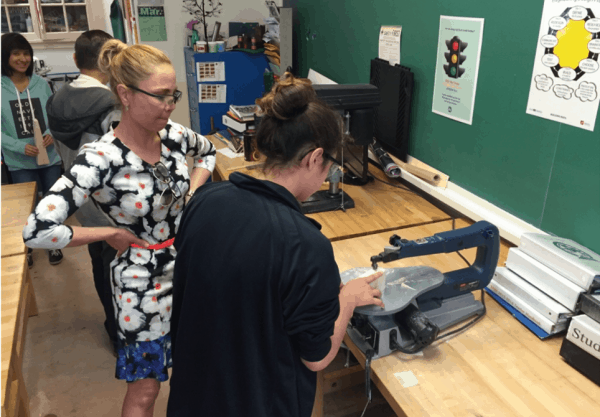Next-Gen High Schools

There’s never been a better time to transform a classroom or open a new school.
This month we visited reinvented active learning classrooms and academies in El Paso (pictured right) and saw new blended schools in Oakland.

We’re excited about 10 networks (supporting 675 schools) piloting personalized project-based learning. We think microschools are a big opportunity and love seeing small academies opening in big traditional high schools.
Next Gen Trends
New school energy is being driven by eight important trends:
- Student-centered: We’ve learned from marketing and software development to deeply consider the user experience, and that has contributed to a renewed focus on learner experience (see 15 Elements of Next-Gen Learner Experiences). Nellie Mae Education Foundation says “Student-centered learning engages students in their own success, and incorporates their interests and skills into the learning process.”
- Access: Now that internet access is cheaper than textbook access, it makes sense to provide take-home tech and design around anywhere, anytime learning.
- Next-gen learning: New learning models blend online and face-to-face experiences to create personalized and competency-based learning sequences (see report on regional funds supporting next-gen school models).
- Broader aims: It’s clear that mindsets and relational skills are at least as important as academic knowledge (see Building Habits of Success and Measuring What Matters and What Should Students Know and Be Able to Do and When?).
- Projects: It’s a project-based economy and learning through projects is a great way to integrate subjects and build career readiness (see Preparing Students for a Project-Based World).
- Connections: It’s more important than ever to gain work experience (see 7 employability skills) and it’s never been easier to access technical training and college credit (see how some high school students graduate with an AA degree). Personal learning plans and advisory can help students make connections and plan for their futures.
- Competency-based education (CBE): To better ensure college and career readiness, high schools are shifting to competency-based learning models that require that students advance upon mastery, receive differentiated support and participate in meaningful assessments (see full working definition of CBE and Summer Reading: What Does Competency Education Look Like for examples).
- Better signaling: Augmenting transcripts of credits are portfolio of artifacts and credentials of verified skills.
While a policy opening is contributing to space for innovation, it’s teachers and leaders investing new learning environments that are providing most of the energy, and school networks and funders are providing support.
School Networks
School networks are one of the most important innovations in modern era of U.S. K-12 education. Charter management networks like Summit Public Schools get all the headlines but networks supporting district schools have achieved similar scale and doing some interesting work. For example:
- NAF supports 667 career academies and is innovating on work skills certification;
- New Tech Network is 200 schools strong and is updating their platform to support personalized project-based learning. In this podcast, we chat with the New Tech Team about what New Tech High got right almost 20 years ago, and why the network has been so successful while other replication and expansion efforts have stalled.
- EL Education has 152 project-based school partners and is innovating on curriculum materials.
- Great Schools Partnership supports a network of 111 innovative proficiency-based high schools in New England. Their advocacy support for proficiency-based diplomas and higher education acceptance of proficiency-based transcripts has produced a regional innovation ecosystem.
Keep an eye on Acton Academy (and its replication partners), One Stone and other microschools for important developments in next-gen high schools.
Next Generation Learning Challenges
With 50 national grantees and another 50 Regional Funds for Breakthrough Schools, Next Generation Learning Challenges (NGLC) ignited the current wave of high school innovation. Formed in 2010 by Educause and initially funded by the Gates Foundation, the funds share a vision of student-centered, personalized, blended, experiential learning designed around richer-deeper definitions of student success.
“The original NGLC breakthrough school design challenge was designed to surface and support bold, fundamentally different school designs submitted by promising, high-capacity organizations,” said director Andy Calkins. Setting a high bar for design (summarized below) initially drew mostly charter school applicants. In subsequent rounds the NGLC team and regional funds made district conversion models a priority.

Two regional funds participate in the d.School/IDEO School ReTool initiative designing to assist school leaders to “hack their schools” towards personalized-learning models.
Funding Important Work
NewSchools Venture Fund has been a leading supporter of new school networks for 15 years. Over the next five years NSVF Invent will support creation of 100,000 quality seats.
Carnegie Corporation supports Opportunity by Design, a small network of urban schools that share a recuperative youth development framework and support from Springpoint Schools. (See our trip report to Denver grantee Denver School of Innovation and Sustainable Development, pictured below.)


- 66 Middle and High Schools Worth Visiting
- What Should High School Graduates Know And Be Able To Do?
- Next Generation K-12: 10 Implications for HigherEd
Stay in-the-know with all things EdTech and innovations in learning by signing up to receive the weekly Smart Update. This post includes mentions of a Getting Smart partner. For a full list of partners, affiliate organizations and all other disclosures please see our Partner page.








0 Comments
Leave a Comment
Your email address will not be published. All fields are required.